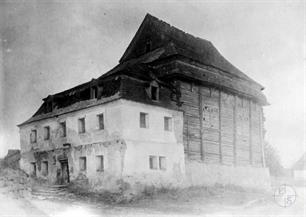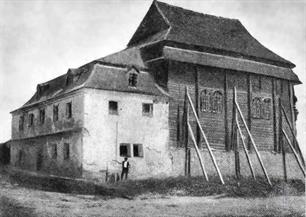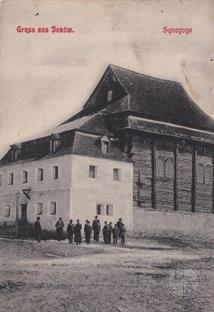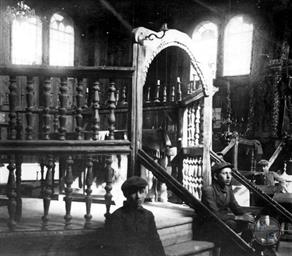Dolyna (Yaniv)
Ternopil region
Sources:
- Pinkas Hakehillot Polin: Encyclopedia of Jewish Communities, Poland, Volume II, page 283, published by Yad Vashem, Jerusalem. Translated by Hadassah Bar-Yakov, JewishGen, Inc.
- Sprawozdanie Kuratorjum opieki nad zabytkami sztuki żydowskiej przy Żydowskiej gmine wyznaniowej we Lwowie. Lwów, 1928.
- Pinkas Hakehillot Polin: Encyclopedia of Jewish Communities, Poland, Volume II, page 283, published by Yad Vashem, Jerusalem. Translated by Hadassah Bar-Yakov, JewishGen, Inc.
- Sprawozdanie Kuratorjum opieki nad zabytkami sztuki żydowskiej przy Żydowskiej gmine wyznaniowej we Lwowie. Lwów, 1928.
Year - Total Population - Jews
1765 - (?) - 390
1860 - 2,145 - 848
1880 - 2,483 - 998
1900 - 2,667 - 749
1921 - 2,292 - 525
1765 - (?) - 390
1860 - 2,145 - 848
1880 - 2,483 - 998
1900 - 2,667 - 749
1921 - 2,292 - 525
In the 17th century Yanov (Yaniv, Янів Теребовельський) was a private little town of nobility, and next to it there was a fortress, which was a place where the people of the area could go when the Tartaric invaded.
Until the end of the 19th century Yanov was not connected to the other cities in the area--not even by a road of pebbles. Because the town was disconnected from the other towns, its development was not possible, and it remained a small place with few business and agricultural opportunities. The ruins of the little town from the time of the Russian occupation were restored during World War I. In the time between the two World Wars, Yanov became more urbanized.
The first time the Jews in Yanov were mentioned was in the certificate from 1628. In the beginning of the 17th century they had become a community. From 1717 until 1762 there was a conflict between the community of Yanov and the other communities in Rizan about a sum of 459 gilders that the Jews in Yanov needed to pay. This conflict got to the courts of the gentiles in the area, and the court of the treasury of Bardom had sent a special committee to make a ruling about this matter. This committee from Rizan didn't listen to the verdict that said that the Yanov community didn't have to pay, and this conflict continued even during the Austrian era.
In 1765 the community of Yanov had 96 Jews who lived in 11 different villages. During that time a synagogue was built that stayed erect until the 20th century. And there was also a cemetery.
In the 60's of the 19th century the people in Yanov reached a peak in terms of their population, but the numbers started declining in the 1890s. The reason for the decline was immigration to larger cities and because of the people moving overseas. By the end of the First World War the “Joint” had helped finish restoring the broken houses and the farms of the Jews in the area, but it didn't reach its full restoration until the beginning of the Second World War.
The main livelihood of the Jews in Yanov in the 19th and 20th centuries was from small trade businesses, peddling in the nearby villages, and workmanship. They also had a charity organization that helped people in need. The “Joint” started this help in 1927. There were 14 trade occupations, 12 merchant businesses, one person who was hired by other people, and two farmers. In 1936 the charity had given 12 loans in the sum of 774 zloty.
We can't say the names of the rabbis who were in Yanov in the 18th and 19th centuries. In the early 20th century there was one called Rabbi Shimon Baabad who later moved to Budzanov. In the 20's the chief Rabbi was Rabbi Yosef Moshinzker, and afterwards there was Rabbi Chaim Schecter in 1935.
Until the end of the 19th century Yanov was not connected to the other cities in the area--not even by a road of pebbles. Because the town was disconnected from the other towns, its development was not possible, and it remained a small place with few business and agricultural opportunities. The ruins of the little town from the time of the Russian occupation were restored during World War I. In the time between the two World Wars, Yanov became more urbanized.
The first time the Jews in Yanov were mentioned was in the certificate from 1628. In the beginning of the 17th century they had become a community. From 1717 until 1762 there was a conflict between the community of Yanov and the other communities in Rizan about a sum of 459 gilders that the Jews in Yanov needed to pay. This conflict got to the courts of the gentiles in the area, and the court of the treasury of Bardom had sent a special committee to make a ruling about this matter. This committee from Rizan didn't listen to the verdict that said that the Yanov community didn't have to pay, and this conflict continued even during the Austrian era.
In 1765 the community of Yanov had 96 Jews who lived in 11 different villages. During that time a synagogue was built that stayed erect until the 20th century. And there was also a cemetery.
In the 60's of the 19th century the people in Yanov reached a peak in terms of their population, but the numbers started declining in the 1890s. The reason for the decline was immigration to larger cities and because of the people moving overseas. By the end of the First World War the “Joint” had helped finish restoring the broken houses and the farms of the Jews in the area, but it didn't reach its full restoration until the beginning of the Second World War.
The main livelihood of the Jews in Yanov in the 19th and 20th centuries was from small trade businesses, peddling in the nearby villages, and workmanship. They also had a charity organization that helped people in need. The “Joint” started this help in 1927. There were 14 trade occupations, 12 merchant businesses, one person who was hired by other people, and two farmers. In 1936 the charity had given 12 loans in the sum of 774 zloty.
We can't say the names of the rabbis who were in Yanov in the 18th and 19th centuries. In the early 20th century there was one called Rabbi Shimon Baabad who later moved to Budzanov. In the 20's the chief Rabbi was Rabbi Yosef Moshinzker, and afterwards there was Rabbi Chaim Schecter in 1935.
 |
 |
 |
| Synagogue in Janiv, approximately 1920. Built about 1700 | Eastern facade | Closer to 1800, a stone extension was erected with a prayer room for women |
 |
 |
| The synagogue was destroyed during World War II | Boys in the synagogue near bima, photo from archive Yad Vashem |
When the Second World War broke out, the Soviet army conquered the town on September 17th 1939. As had happened in other towns, the first people who were harmed by this were the Jewish merchants. Their supplies were confiscated, and their private trading was forbidden, and some of the people were even brought to court. The Jewish community was scattered around, and they weren't allowed to have any kind of organizations or anything that had to do with Zionism. The Jews tried to gain work in official organizations, or in governmental offices, or in factories that Yanov itself had, or in some other towns that were nearby, like Budzanov. They wanted these jobs so that they would be considered as productive people and saved from being sent to the outskirts of the Soviet Union. This had happened to some of the families in Yanov.
When the war between the Germans and Soviets started, most of the young people were enlisted in the Red army, and they had to leave the little city. In the first days of the German conquest many Jews were shot to death, and 10 Jews were arrested under the pretense that they had murdered Ukrainian policemen. These prisoners were held for three days in a prison in Yanov. They were starved and tortured, and they were released only when their families paid a very high ransom.
During these times a group of people who were expelled from Karpoutros – most of them were women – came to the city. These women were starving and exhausted, and their men had been murdered or were abducted and sent for forced labor. The assault on the Jews and the robbery of their possessions and abduction for work, hitting them, and torturing them were things that were done every day.
During this time the Judenrat [Jews appointed by the Germans to act as policemen for them] were torn because they wanted to save themselves, but they had to do bad things against the other Jews in their community. Nathan Meir Weisbord was selected as the head of the Judenrat. Getting through became much, much harder because they couldn't leave their little town. Whoever left the little city risked their life because they could be killed by the Germans or by the Ukrainian policemen. The farmers sold food to the Jews but only for really valuable things that they had, for clothes and for whatever else they had.
The little Jewish community in Yanov had been eliminated by the second half of September 1942. The Jews were commanded to move within three days to the ghetto in Trembovla. According to different information that they have, the Gestapo order was given from Tarnopol about moving the Jews of Yanov to Trembovla in the end of October. The final date that this was going to happen was November 1, 1942. This very short notice for them to get organized and move caused the Jews to leave most of their possessions behind.
The people who left were brought to Trembovla in wagons, and Ukrainian policemen supported them. The wealthy refugees rented houses from the Jews in the area that they moved to and moved in. For the other people, the Judenrat put them up in different Jewish establishments, like synagogues, where they were very crowded, and the conditions were horrible. In the first elimination action on the 5th of November 1942 the people who were taken away from Yanov were sent to the *concentration camp in Belzec, and after this action there were only thirty-five of the Yanov Jews left.
About 20 of the Jewish people from Yanov survived in that area during the war because they were hiding. A Ukrainian farmer, Vladik Krivoruka, who was poor, saved 13 Jews. He gave them shelter and helped them out. Another group of Jews from Yanov were saved because they were in the USSR before the war.
After the war some of the Jews stayed in Yanov for a very short time because most of the synagogues there and the Jewish homes were destroyed. They moved to bigger cities. Most of them went to Zbaraz, and then they went to the Soviet Union, and from there they went west, or mainly to Israel.
When the war between the Germans and Soviets started, most of the young people were enlisted in the Red army, and they had to leave the little city. In the first days of the German conquest many Jews were shot to death, and 10 Jews were arrested under the pretense that they had murdered Ukrainian policemen. These prisoners were held for three days in a prison in Yanov. They were starved and tortured, and they were released only when their families paid a very high ransom.
During these times a group of people who were expelled from Karpoutros – most of them were women – came to the city. These women were starving and exhausted, and their men had been murdered or were abducted and sent for forced labor. The assault on the Jews and the robbery of their possessions and abduction for work, hitting them, and torturing them were things that were done every day.
During this time the Judenrat [Jews appointed by the Germans to act as policemen for them] were torn because they wanted to save themselves, but they had to do bad things against the other Jews in their community. Nathan Meir Weisbord was selected as the head of the Judenrat. Getting through became much, much harder because they couldn't leave their little town. Whoever left the little city risked their life because they could be killed by the Germans or by the Ukrainian policemen. The farmers sold food to the Jews but only for really valuable things that they had, for clothes and for whatever else they had.
The little Jewish community in Yanov had been eliminated by the second half of September 1942. The Jews were commanded to move within three days to the ghetto in Trembovla. According to different information that they have, the Gestapo order was given from Tarnopol about moving the Jews of Yanov to Trembovla in the end of October. The final date that this was going to happen was November 1, 1942. This very short notice for them to get organized and move caused the Jews to leave most of their possessions behind.
The people who left were brought to Trembovla in wagons, and Ukrainian policemen supported them. The wealthy refugees rented houses from the Jews in the area that they moved to and moved in. For the other people, the Judenrat put them up in different Jewish establishments, like synagogues, where they were very crowded, and the conditions were horrible. In the first elimination action on the 5th of November 1942 the people who were taken away from Yanov were sent to the *concentration camp in Belzec, and after this action there were only thirty-five of the Yanov Jews left.
About 20 of the Jewish people from Yanov survived in that area during the war because they were hiding. A Ukrainian farmer, Vladik Krivoruka, who was poor, saved 13 Jews. He gave them shelter and helped them out. Another group of Jews from Yanov were saved because they were in the USSR before the war.
After the war some of the Jews stayed in Yanov for a very short time because most of the synagogues there and the Jewish homes were destroyed. They moved to bigger cities. Most of them went to Zbaraz, and then they went to the Soviet Union, and from there they went west, or mainly to Israel.

- Home
- Shtetls
- Vinnytsia region
- Volyn region
- Dnipro region
- Donetsk region
- Zhytomyr region
- Zakarpattia region
- Zaporizhzhia region
- Ivano-Frankivsk region
- Kyiv region
- Kropyvnytskyi region
- Luhansk region
- Lviv region
- Mykolayiv region
- Odessa region
- Poltava region
- Rivne region
- Sumy region
- Ternopil region
- Kharkiv region
- Kherson region
- Khmelnytskyi region
- Chernihiv region
- Chernivtsi region
- Cherkasy region
- Crimea
- Synagogues
- Cemeteries
- Objects & guides
- Gallery
- History
- Contact
Jewish towns of Ukraine
Jewish towns of Ukraine
My shtetl
My shtetl
Donate